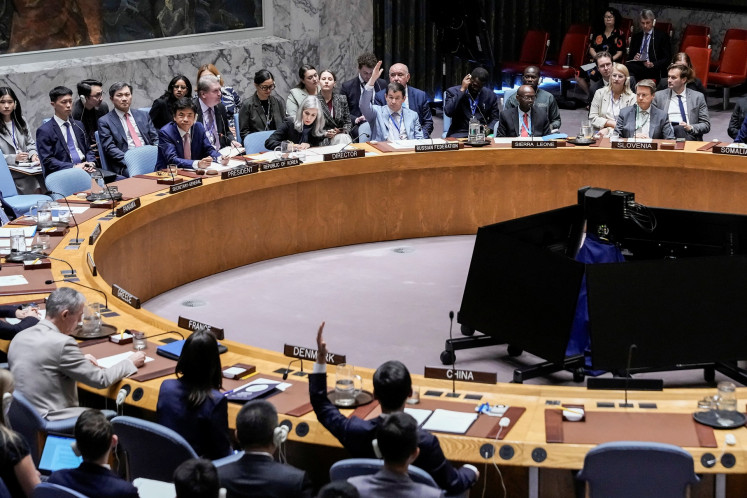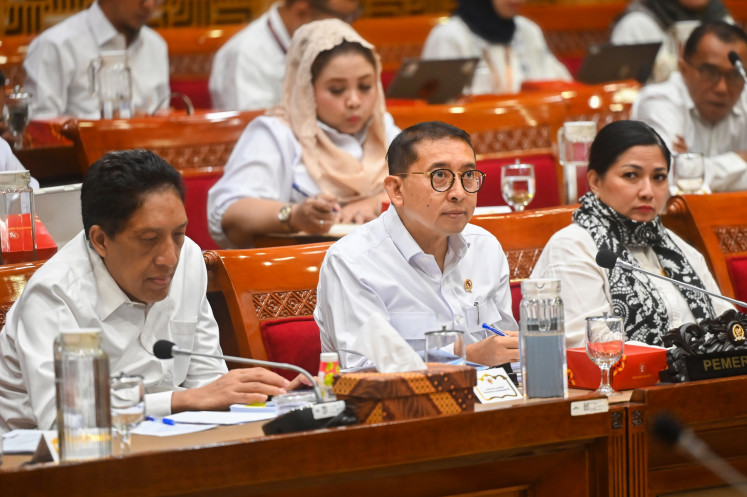Popular Reads
Top Results
Can't find what you're looking for?
View all search resultsPopular Reads
Top Results
Can't find what you're looking for?
View all search resultsSouth Korea: A trusted friend and reliable partner of ASEAN
South Korea’s charismatic President Lee Myung-bak, a close friend of President Susilo Bambang Yudhoyono, is currently on Bali Island to attend the ASEAN+3 and East Asian Summit meetings and further strengthen the already close and mutually beneficial relations between South Korea and ASEAN
Change text size
Gift Premium Articles
to Anyone
S
outh Korea’s charismatic President Lee Myung-bak, a close friend of President Susilo Bambang Yudhoyono, is currently on Bali Island to attend the ASEAN+3 and East Asian Summit meetings and further strengthen the already close and mutually beneficial relations between South Korea and ASEAN.
South Korea’s success story from rags to riches (from a poor country in the 1950s to a US$1 trillion economy) in a short span of time inspires millions in Southeast Asia and elsewhere.
“To outsiders, South Korea’s heroic economic ascent is a template for success,” commented The Economist magazine in its recent edition.
Southeast Asia, a strategically located dynamic region with 600 million people, is a perfect match for South Korea. Both are made for each other.
“Given Korea’s status as an economic power, its lack of political ambitions and its situation between Japan and China, mediation from it would be more acceptable to other Asian countries,” Edy Prasetyono, an Indonesian scholar, wrote in the ASEAN-Korea Relations Security, Trade and Community Building book published by the Singapore-based Institute of Southeast Asian Studies.
“Cooperation with ASEAN would therefore increase Korea’s strategic weight.”
South Korea, the fourth-largest economy in Asia, is a synonym for speed and dynamism.
South Korea and ASEAN relations are progressing at a rapid pace, from a sectoral dialogue partner in 1989, to full dialogue partner in 1991, then to a comprehensive cooperation partnership in 2004 and finally to a strategic partnership in 2010. In just 22 years, the economic, political and cultural interaction, a free trade agreement, continuous foreign direct investment (FDI) flows and mutually beneficially cooperation in various fields have changed the shape and size of relations between ASEAN and South Korea.
As a result of speedy developments, many South Koreans are still either left behind in the developments or unaware of the potential of Southeast Asia, which has a combined GDP of almost $2 trillion and abundant natural resources.
“Many people in Korea still think that the US and European countries are Korea’s major trading partners. At present, ASEAN is indeed the second-biggest trading partner of South Korea after China. One of our major investment destinations is also Southeast Asia,” Lee Sun-jin, an expert on Southeast Asia and former South Korean ambassador to Indonesia, told The Jakarta Post recently in Seoul
Despite the financial turmoil in the US and Europe, according to the South Korean Embassy in Jakarta, two-way trade between South Korea and ASEAN increased 31 percent from $74.7 billion in 2009 to $97.29 billion in 2010.
In 2010, South Korea exported $53.19 billion worth of goods to ASEAN and imported $44.1 billion worth of goods from Southeast Asia. South Korea is ASEAN’s fifth-largest trading partner.
South Korean exports to ASEAN are mainly semiconductors, refined petroleum products, TV screens, electronic goods, vehicles, steel, cell phones, chemicals, ICT, ships and machinery, while its imports from Southeast Asia are mainly oil and gas, coal, paper, rubber, wood products and garments.
On the investment side, in 2010, South Korea’s FDI flow into ASEAN was $3.8 billion, an impressive surge of more than 100 percent from $1.4 billion in 2009. This makes South Korea ASEAN’s fourth-largest investor. From 1968 to 2010, South Korea’s cumulative FDI inflows reached $34.2 billion.
Most of South Korea’s investments are in labor intensive and export-oriented industries like footwear, garments, electronic and electrical goods and chemicals. This has led to the creation of hundreds of thousands of new jobs in Southeast Asia.
Around 200,000 Southeast Asian people, mostly working in Korean factories, live in South Korea. In 2010, more than 3.2 million South Korean tourists visited Southeast Asia, bringing in billions of dollars.
South Korea’s focus is not just limited to economic interaction.
“We have very strong relations with Indonesia and other Southeast Asian countries. But we just don’t want to focus only on trade and investment. We want to focus more on cultural exchanges and people-to-people contacts,” South Korean Ambassador to Indonesia Kim Young-sun told the Post.
The “Korean Wave”, or hallyu, in the form of songs, music, films and TV dramas is currently sweeping Southeast Asia.
With the realization of the ASEAN-Korea Free Trade Area on Jan. 1, 2010, the doors for the further fostering of relations are wide open. South Korea is indeed a trusted friend and a reliable partner in politics, business, security and cultural fields.










